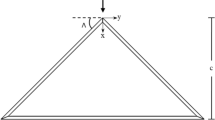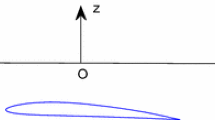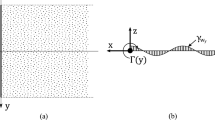Abstract
Although it has some limitations in applications, the classical Prandtl lifting line theory remains a standard methodology for evaluating lifting problems in free space. It is of theoretical interest in revealing lifting mechanisms. It is therefore, interesting to generalize the classical lifting line theory to cases more general than just the free space problem. In this article, we present the Prandtl lifting line theory for wing-in-ground effect (WIG) near a free surface. While, the fundamental methodology being similar to the classical lifting line theory, it turns out that the difficulty lies in finding the three-dimensional Green’s function for the system of horseshoe vortices operating over the deformable free surface. Linear free surface boundary conditions are applied to deal with the two-dimensional lifting problem solved by the singularity distribution method and the three-dimensional correction found by placing a system of horseshoe vortices on the wing. This approach was validated against published data. Excellent agreement is found among results obtained from this study, experiments and numerical simulations. Extensive numerical examples are carried out to show the features of lift coefficients in the vicinity of a free surface. As expected, the free surface can be represented by a rigid wall for the case of high velocity. Finally, the free surface effect on WIG is discussed.
Similar content being viewed by others
References
Rozhdestvensky K (2000) Aerodynamics of a lifting system in extreme ground effect, 1st ed. Springer-Verlag, Berlin
Halloran M, O’Meara S (1999) Wing in ground effect craft review. DSTO Aeronautical and Maritime Research Laboratory, Australia
Deese JE, Agarwa RK (1986) Euler calculation for flow over a wing in ground effect. AIAA 86: 10–15
Kang CG (2006) Development of WIG Craft. Marine Transportation & Safety Research. Annual Report 2006, 61
Bennett L, Frank A, McLoughlin T, Moreton R, Randell S, Wong S (2005) Wing in Ground Effect (WIG) aircraft Aerodynamics. School of mechanical engineering, Adelaide, Mech Eng 3016
Rozhdestvensky K (2006) WIG vehicles. Prog Aerosp Sci 42: 211–283
Raymond AE (1921) Ground influence on airfoils. NACA Technical Note 67
Reid EG (1927) A full scale investigation of ground effect. NACA Technical Report 265
Abramowski T (2007) Numerical investigation of airfoil in ground proximity. J Theor Appl Mech 45: 425–436
Ahmed MR, Sharma SD (2005) An investigation on the aerodynamics of a symmetrical airfoil in ground effect. Exp Therm Fluid Sci 29: 633–647
Jung KH, Chun HH, Kim HJ (2008) Experimental investigation of WIG with a NACA6409 section. J Mar Sci Technol 13: 317–327
Nuhait AO, Mook DT (1989) Numerical simulation of wings in steady and unsteady ground effects. J Aircr AIAA 26: 1081–1089
Dragos L, Dinu A (1995) A direct boundary integral equations method to subsonic flow with circulation past thin airfoils in ground effect. Comput Methods Appl Mech Eng 121: 163–176
Chun HH, Chang CH (2002) Longitudinal stability and dynamic motions of a small passenger WIG craft. Ocean Eng 29: 1145–1162
Tan CH, Plotkin A (1986) Lifting-line solution for a symmetrical thin wing in ground effect. AIAA J 24: 1193–1194
Han C, Kim H, Cho J (2006) Steady aerodynamic characteristics of a wing flying over a nonplanar ground surface part i: rail. J Mar Sci Technol 20: 1043–1050
Han C, Kim H, Cho J (2006) Steady aerodynamic characteristics of a wing flying over a nonplanar ground surface part ii: channel. J Mar Sci Technol 20: 1051–1058
Dragos L, Dinu A (1995) A direct boundary integral equations method to subsonic flow with circulation past thin airfoils in ground effect. Comput Methods Appl Mech Eng 121: 163–176
Rozhdestvensky K (1995) Nonlinear aerodynamics of Ekranoplan in strong ground effect. In: Proceedings 3rd international conference on fast sea transportation (FAST 95), Luberk-Travemunde, 25–27 September
Suzuki K, Ikehata M (1994) Free surface effect of WIG advancing over the still water surface. In: Proceeding of the international conference on hydrodynamics (ICHD’94), 254–260
Barber TJ (2007) A study of water surface deformation due to tip vortices of a WIG. J Ship Res 51: 182–186
Prandtl L (1921) Application of modern hydrodynamics aeronautics, NACA Rept. 116
Van Dyke MD (1964) Lifting-line theory as a singular perturbation problem. Appl Math Mech 28: 90–101
Guermond JL, Sellier A (1991) A unified lifting-line theory. J Fluid Mech 229: 427–451
Anderson JD (2007) Fundamental of aerodynamics, 4th edn. McGraw-Hill, New York
Katz J, Plotkin A (1991) Low speed aerodynamics: from wing theory to panel methods. McGraw-Hill, Signapore
Voitkunskii YI (1988) Resistance to the motion of ships (in Russian). Sudostroenie, Leningrad
Newman JN (1977) Marine hydrodynamics. MIT Press, Cambridge
Smith JL, Graham HZ, Smith JE (2008) The validation of an airfoil in the ground effect regime using 2-D CFD analysis. In: AIAA Paper 2008–4262, 26th AIAA aerodynamic measurement technology and ground testing conference
Lan CE, Fasce MH (1976) Application of an improved nonlinear lifting-line theory. AIAA J 14: 404–407
Lan CT (1974) An improved nonlinear lifting-line theory. AIAA J 11: 739–742
Faltinsen OM (2005) Hydrodynamics of high-speed marine vehicles. Cambridge University Press, New York
Abramowitz M, Stegun IA (1972) Handbook of mathematical functions. Dover, New York
Liang H, Zong Z (2011) A subsonic lifting surface theory for wing-in-ground effect. ACTA Mech 219: 203–217
Hadamard J (1923) Lectures on Cauchy’s problem in linear partial differential equation. Yale University Press, New York
Gulcat U (2010) Fundamental of modern unsteady aerodynamics. Springer, Heidelberg
Author information
Authors and Affiliations
Corresponding author
Rights and permissions
About this article
Cite this article
Zong, Z., Liang, H. & Zhou, L. Lifting line theory for wing-in-ground effect in proximity to a free surface. J Eng Math 74, 143–158 (2012). https://doi.org/10.1007/s10665-011-9497-x
Received:
Accepted:
Published:
Issue Date:
DOI: https://doi.org/10.1007/s10665-011-9497-x




